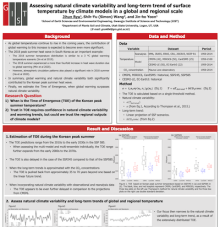Assessing natural climate variability and long-term trend of surface temperature by climate models in a global and regional scale
Jihun
Ryu
Gwangju Institute of Science and Technology(GIST)
Poster
Climate models are designed to replicate the observed climate as accurately as possible, but each model has its own limitations. Multiple models and ensembles are often used to portray a model's performance in a probabilistic manner. This study compares natural climate variability and long-term trends of surface air temperature simulated by climate models are compared with observations, including station data and reanalysis. Climate models tend to overestimate both natural climate variability and long-term trend on a global scale. Focusing on a particular region, in this case, Korea, it seems that climate model-simulated natural climate variability of surface air temperature during the seasonally warmer months – July and August – is underestimated, while the global warming-induced long-term trend is overestimated.
A statistical model was developed and employed to evaluate the importance of natural climate variability on temperatures during Korean peak summer from 1959 to 2014. The model relied on observed temperature and atmospheric CO2 concentration. The research findings suggest that natural climate variability remains a significant factor in regional temperature fluctuations. Incorrectly estimating this variability and overestimating long-term trends in peak summer temperatures may magnify presumed global warming effects in climate models. A more objective evaluation can be achieved using the time of emergence (TOE), denoting the point at which global warming effects exceed natural climate variability. Calculated using multiple model, multiple ensemble projections plus two different methods to estimate natural variability and long-term trends, the TOEs are widely predicted to occur between 2002 and the 2070s. This brings attention to the importance of thorough analysis as there are inherent uncertainties in computing the timing of these changes.
A statistical model was developed and employed to evaluate the importance of natural climate variability on temperatures during Korean peak summer from 1959 to 2014. The model relied on observed temperature and atmospheric CO2 concentration. The research findings suggest that natural climate variability remains a significant factor in regional temperature fluctuations. Incorrectly estimating this variability and overestimating long-term trends in peak summer temperatures may magnify presumed global warming effects in climate models. A more objective evaluation can be achieved using the time of emergence (TOE), denoting the point at which global warming effects exceed natural climate variability. Calculated using multiple model, multiple ensemble projections plus two different methods to estimate natural variability and long-term trends, the TOEs are widely predicted to occur between 2002 and the 2070s. This brings attention to the importance of thorough analysis as there are inherent uncertainties in computing the timing of these changes.

Poster file
jihun-ryu- onfronting-poster.pdf
(874.33 KB)
